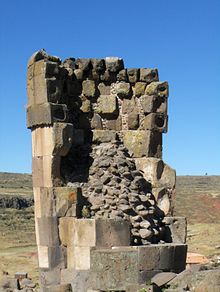Chullpa

As Chullpa the territory of the Central will Andes in Bolivia and Peru to Aymara and Quechua referred towers, as tombs ( mausoleums served) and in the time of the Inca or before - partly in the Tiwanaku -Culture (6th to 10th century) - were erected.
Chullpas are spread over the entire Altiplano in Peru and Bolivia, but the towers of Sillustani on Lake Umayo in the Peruvian region of Puno , originating in the Kolla culture between the 13th and 15th centuries, are considered to be the best preserved. The highest chullpa can also be found here with a height of 12 meters . There are also numerous chullpas on the slopes of the Sajama snow mountain . Many chullpas have been destroyed by grave robbers or geological events; others, on the other hand, were never completed.
In a chullpa a dead person - member of a noble family - was buried in a crouching position with possessions such as clothing, jewelry and equipment. A chullpa almost always has only one opening, and that is towards the east towards the rising sun. While the chullpas in the northern Altiplano have a circular floor plan and are made of stone - mostly of ashlars and, as far as they were built in the Inca period, without mortar - the towers further south have a rectangular floor plan and are made of adobe . While many chullpas are unadorned, numerous burial towers have ornaments carved into sillustani in the form of lizards , whose regrowing tails are a symbol of resurrecting life.
Due to the dry climate, the corpses are often mummified . In the mythology of the Quechua of Q'ero , the mummies in the Chullpas are considered to be relics of the ancestors (Ñawpa Machu or Chullpa Machu) of an era before the Inca ( Inkarrí ) and are associated with evil spirits ( Suq'a or Condenado ) brought.
literature
- Max Uhle: Nature and Order of the Ancient Peruvian Cultures . Bibliotheca Iberoamericana. Colloquium Verlag, Berlin 1959, p. 94ff.
- Thomas Müller and Helga Müller-Herbon: The children in the middle. The Q'ero Indians . Lamuv Verlag, Göttingen 1993, pp. 42, 54, 231.
